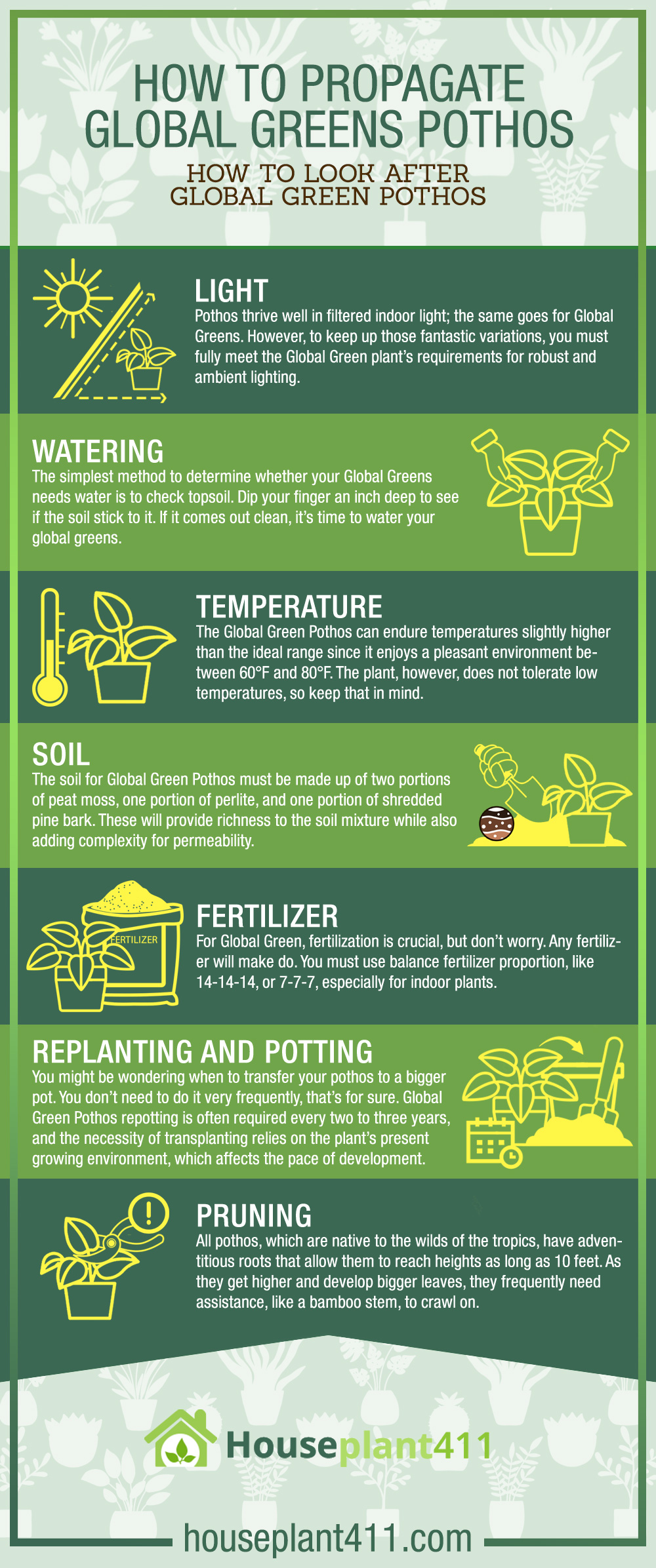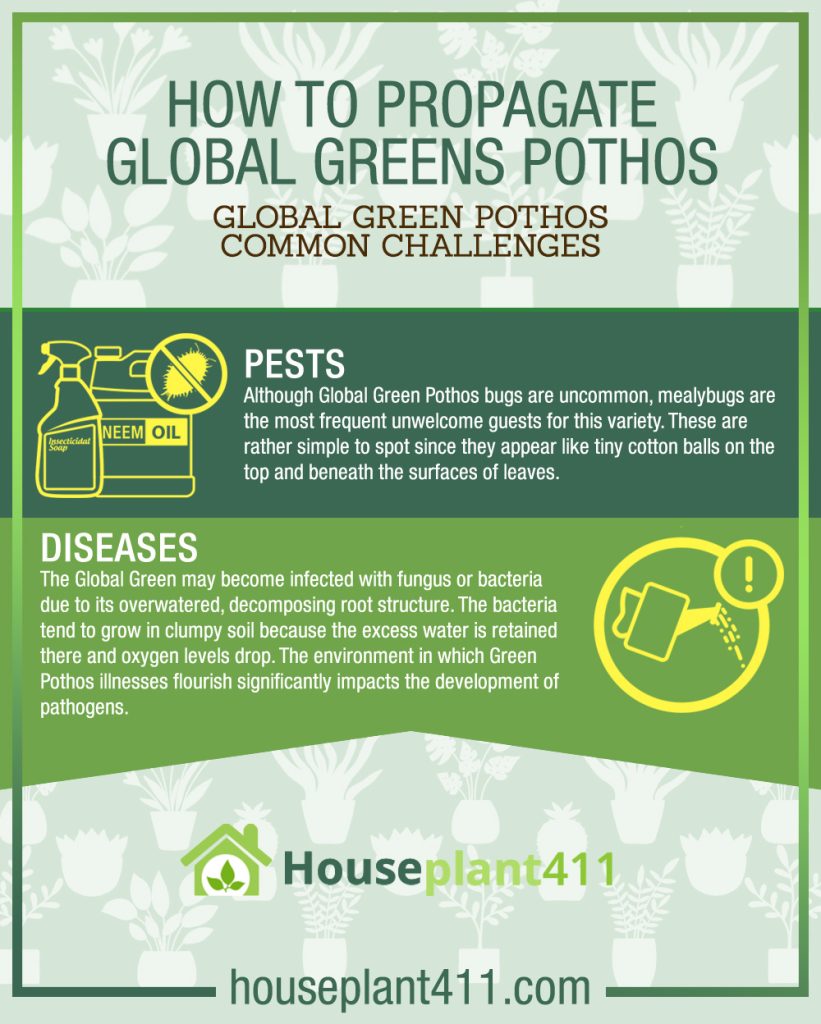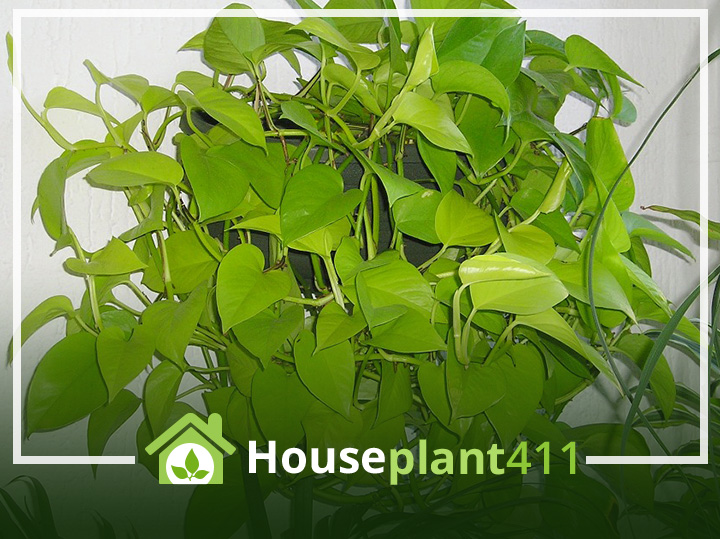Pothos plants are seen vining and swaying through every cafe and office corridor, but only some of you would have ever come across the ‘Global Greens.’ Due to the online buzz around this distinctive colored variety, finding it in traditional horticultural stores may be challenging.
They are a touch more expensive than other less uncommon types due to their appeal and uniqueness. But as soon as you have these lush, tropical vines with tints of lime green, you’ll want to have more and more.
If you have green pothos already and want to have more, green pothos propagation is relatively straightforward. This guide highlights the step-wise method for green pothos propagation and the care and growth tips for nurturing this rare plant.
What Makes Global Green Pothos Special
The famous tropical houseplant pothos now comes in a new strain called Epipremnum aureum “Global Green.” It is renowned for its variegated leaves that are bright and lime-green, as well as its adaptability to various growth environments. Like all other pothos, this variety needs strong yet filtered light to perpetuate its striking variegated look.
The Global Green Pothos plant is native to an island in the southern Pacific and is a possibly uncommon find.
The glossy surface has a distinctive design that ranges in color from emerald to lime green. The leaf center occasionally has a bright green splotch, and the margins are a darker green.
Global Green Pothos plants are even more attractive with their magnificent structure and vivid look.
They have become increasingly popular and are frequently potted as a garden piece, an interior swinging vine, or a stunning display on the walls.
Despite being rare, these tropical plants are valuable, and many horticultural marketplaces offer them.
Global Green Pothos Planting and Propagation
You can’t grow Global Green Pothos for sale since they are all trademarked. However, it’s completely acceptable if you wish to grow a longer and thicker plant and grow more branches for your home.
Growing pothos that is happy and flourishing requires both propagation and pruning. Propagating Global Green is similar to how it is done for other pothos varieties.
Propagating Global Green Pothos With Cutting
In indoor environments, pothos plants rarely achieve maturation; as a result, they’re replicated in vegetative reproduction using cuttings instead of sexual reproduction, which requires seeds. Propagation is a straightforward approach to expand your stock of pothos while promoting healthier development in your current blooms.
Cutting Technique
- Start with a mother plant’s healthy, active vine.
- To stop diseases or infections from invading the plant, disinfect a razor blade or clippers in a 10% alcohol solution.
- Cut at a 45° angle below the rear node, leaving 3-4 leaves from the vine’s tip.
Nodes are all those yellowish nubs that protrude where the leaflets join the leaf stem. The root grows out of the nodes; therefore, ensure the cutting has at least two nodes that can be dipped in the water.
Where to Keep the Cuttings?
- Take a jar or container and fill it with fresh water at room temperature. Now, place the cutting in the jar, ensuring the nodes are submerged in water fully.
- Now place the jar in a well-illuminated space, ensuring bright indirect sunlight is within reach.
- The pothos cutting typically takes several weeks to start developing roots. You may transfer it to a well-drained soil mix after it has strong roots, about two to four inches long.
Cuttings are also rooted in the soil mix, perlite, and peat moss, but rooting in water is relatively simple. Make sure you change the water every five days to prevent algae growth.
No matter how you go about it, it’s crucial to maintain constantly warm temperatures while keeping the baby cuts adequately humidified.
Instructions for Planting Global Green Pothos
If you’ve already rooted a pothos cutting, it needs to be up-potted to give it more space to grow. Transplanting healthier flourishing plants every six to eight months is essential.
Pothos Transplanting Indications
Before being transplanted, Global Green plants need to be slightly bound to roots but not excessively knotted. Seeing roots draping over the pot’s base or sprouting out from the outflow hole is possible. It is time for transplantation if this is the case!
Don’t panic if you’ve unintentionally put off up-potting the pothos. Even though they are incredibly tolerant, it will be helpful to use a fork or fingers to break up any entangled or whirling roots so that the roots are adequately buried in the soil with you change the container.
Tips for For Potting Global Green Pothos
- Prepare a fresh pot first, preferably one almost twice as large as the current one.
- Add high-quality, well-drained soil mix. Make a hole in the center with your fingers to carefully place the roots in the soil mix.
- Now fill up the pot with more soil mix tapping it from the surface to ensure the plant stays erect. Don’t tap it too hard, making it compact. Pothos plants need to be well-aerated; otherwise, there is the chance of root rot.
- For better growth, you can shower some diluted growth hormone at this stage. While watering the pot, make sure to use room temperature water and fill the pot about 1/4th of the volume of the container. Make sure there is a drainage hole in the pot.
- Now place the pot where there is bright yet indirect light. Make sure to water the pot once the topsoil is completely dry. Pothos plants will not survive in saturated soil.
How to Look After Global Green Pothos
The Global Green Pothos plant requires little maintenance. However, it must be grown in a location with strong indirect light. You can manage if you provide the optimum quantity of water, give your plants periodic fertilizers, and choose a soil mixture that drains well.
Here are some more pointers to help you take the best care of your Global Pothos.
Light
Pothos thrive well in filtered indoor light; the same goes for Global Greens. However, to keep up those fantastic variations, you must fully meet the Global Green plant’s requirements for robust and ambient lighting.
Whether planted indoors or out, ensure the plants get adequate light to flourish well and maintain their vibrancy. As extended direct sunlight might harm your global green pothos’ leaves, it is best to expose them to some afternoon shelter.
Watering
Global Greens don’t like standing in damp soil, which might be a concern, mainly if it lasts for an extended time. They’re also not overly demanding water.
The simplest method to determine whether your Global Greens needs water is to check topsoil. Dip your finger an inch deep to see if the soil stick to it. If it comes out clean, it’s time to water your global greens.
Temperature
The Global Green Pothos can endure temperatures slightly higher than the ideal range since it enjoys a pleasant environment between 60°F and 80°F. The plant, however, does not tolerate low temperatures, so keep that in mind.
Just make sure to put the plant somewhere that isn’t directly in the sun or near any windows where it can be subjected to chilly draughts.
Unlike other indoor plants, the Global Green Pothos temperature gradient is quite simple to achieve. However, you should avoid letting it fall under 50°F because they’re susceptible to death in shallow temperatures.
Soil
The soil for Global Green Pothos must be made up of two portions of peat moss, one portion of perlite, and one portion of shredded pine bark. These will provide richness to the soil mixture while also adding complexity for permeability. Choose potting mixtures commonly used in aroids if you must buy commercially available ones. To safeguard the roots of your pothos and increase soil organic matter content, sprinkle with manure now and then.
The recommended pH range for Global Greens is pH 6.0 to 6.5. When growing Global Green, stay away from tightly packed soil since it retains too much humidity and puts the pothos at risk of root decay.
Fertilizer
For Global Green, fertilization is crucial, but don’t worry. Any fertilizer will make do. You must use balance fertilizer proportion, like 14-14-14, or 7-7-7, especially for indoor plants.
The plants will develop more quickly and keep their brilliant leaves if you fertilize them every 6 to 8 weeks. Avoid using low-quality fertilizers since they might damage the roots and eventually build up in the soil. An all-purpose fertilizer from a reputable retailer will also work fine.
Replanting and Potting
You might be wondering when to transfer your pothos to a bigger pot. You don’t need to do it very frequently, that’s for sure. Global Green Pothos repotting is often required every two to three years, and the necessity of transplanting relies on the plant’s present growing environment, which affects the pace of development. The plant does, however, have a fairly dispersed root system. But once you notice that it’s rootbound, change the pot.
Pruning
All pothos, which are native to the wilds of the tropics, have adventitious roots that allow them to reach heights as long as 10 feet. As they get higher and develop bigger leaves, they frequently need assistance, like a bamboo stem, to crawl on. Therefore, consider pruning your Global Greens if you see some withered foliage, only adding additional weight to the vine.
If Global Greens are cultivated inside, routine trimming is not required, but you can always trim the plant on occasion to maintain it tidy, active, and appear healthier and fuller.

Global Green Pothos: Common Challenges
Unsuccessful cultural care, which provides a breeding ground for insects and pathogens, is a typical cause of difficulties with the global green pothos. When the right growth conditions are not provided, the plant could shed its leaves and turn green, losing its variegation.
Some common problems include:
Pests
Although Global Green Pothos bugs are uncommon, mealybugs are the most frequent unwelcome guests for this variety. These are rather simple to spot since they appear like tiny cotton balls on the top and beneath the surfaces of leaves.
Apply insecticidal wash or neem oil to eliminate predatory insects that could harm your Global Green. Additionally, you can also use alcohol or water to wipe them away.
Make wiping your plants a routine to keep everything clean and your plants looking healthy. Maintaining an ideal amount of humidity levels is essential because, occasionally, an increased rate of pests and illnesses is caused by damp surfaces.
Diseases
The Global Green may become infected with fungus or bacteria due to its overwatered, decomposing root structure. The bacteria tend to grow in clumpy soil because the excess water is retained there and oxygen levels drop. The environment in which Green Pothos illnesses flourish significantly impacts the development of pathogens. Therefore, it could be wise to wait to water until the surface soil appears dry when touched. Ensure the growth media is not excessively thick and the container has a proper drainage system. Avoid soaking wet soils; if any sick plant pieces are found, remove them immediately.


